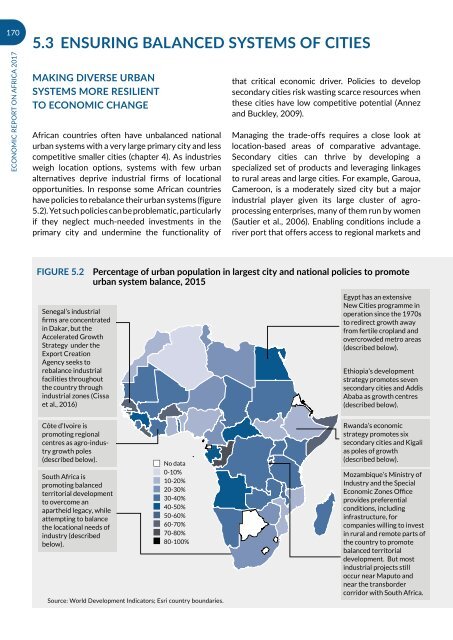URBANIZATION AND INDUSTRIALIZATION
Economic%20Report%20on%20Africa%202017%20UNECA
Economic%20Report%20on%20Africa%202017%20UNECA
You also want an ePaper? Increase the reach of your titles
YUMPU automatically turns print PDFs into web optimized ePapers that Google loves.
170<br />
ECONOMIC REPORT ON AFRICA 2017<br />
5.3 ENSURING BALANCED SYSTEMS OF CITIES<br />
MAKING DIVERSE URBAN<br />
SYSTEMS MORE RESILIENT<br />
TO ECONOMIC CHANGE<br />
African countries often have unbalanced national<br />
urban systems with a very large primary city and less<br />
competitive smaller cities (chapter 4). As industries<br />
weigh location options, systems with few urban<br />
alternatives deprive industrial firms of locational<br />
opportunities. In response some African countries<br />
have policies to rebalance their urban systems (figure<br />
5.2). Yet such policies can be problematic, particularly<br />
if they neglect much-needed investments in the<br />
primary city and undermine the functionality of<br />
that critical economic driver. Policies to develop<br />
secondary cities risk wasting scarce resources when<br />
these cities have low competitive potential (Annez<br />
and Buckley, 2009).<br />
Managing the trade-offs requires a close look at<br />
location-based areas of comparative advantage.<br />
Secondary cities can thrive by developing a<br />
specialized set of products and leveraging linkages<br />
to rural areas and large cities. For example, Garoua,<br />
Cameroon, is a moderately sized city but a major<br />
industrial player given its large cluster of agroprocessing<br />
enterprises, many of them run by women<br />
(Sautier et al., 2006). Enabling conditions include a<br />
river port that offers access to regional markets and<br />
Figure 5.2 Percentage of urban population in largest city and national policies to promote<br />
urban system balance, 2015<br />
Senegal’s industrial<br />
firms are concentrated<br />
in Dakar, but the<br />
Accelerated Growth<br />
Strategy under the<br />
Export Creation<br />
Agency seeks to<br />
rebalance industrial<br />
facilities throughout<br />
the country through<br />
industrial zones (Cissa<br />
et al., 2016)<br />
Egypt has an extensive<br />
New Cities programme in<br />
operation since the 1970s<br />
to redirect growth away<br />
from fertile cropland and<br />
overcrowded metro areas<br />
(described below).<br />
Ethiopia’s development<br />
strategy promotes seven<br />
secondary cities and Addis<br />
Ababa as growth centres<br />
(described below).<br />
Côte d’Ivoire is<br />
promoting regional<br />
centres as agro-industry<br />
growth poles<br />
(described below).<br />
South Africa is<br />
promoting balanced<br />
territorial development<br />
to overcome an<br />
apartheid legacy, while<br />
attempting to balance<br />
the locational needs of<br />
industry (described<br />
below).<br />
No data<br />
0-10%<br />
10-20%<br />
20-30%<br />
30-40%<br />
40-50%<br />
50-60%<br />
60-70%<br />
70-80%<br />
80-100%<br />
Source: World Development Indicators; Esri country boundaries.<br />
Rwanda’s economic<br />
strategy promotes six<br />
secondary cities and Kigali<br />
as poles of growth<br />
(described below).<br />
Mozambique’s Ministry of<br />
Industry and the Special<br />
Economic Zones Office<br />
provides preferential<br />
conditions, including<br />
infrastructure, for<br />
companies willing to invest<br />
in rural and remote parts of<br />
the country to promote<br />
balanced territorial<br />
development. But most<br />
industrial projects still<br />
occur near Maputo and<br />
near the transborder<br />
corridor with South Africa.


